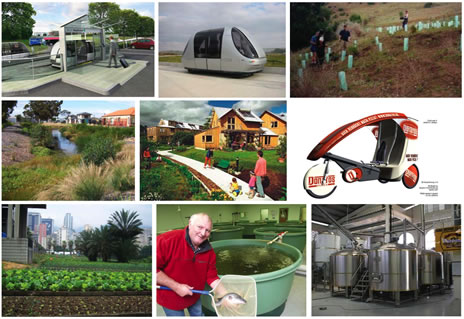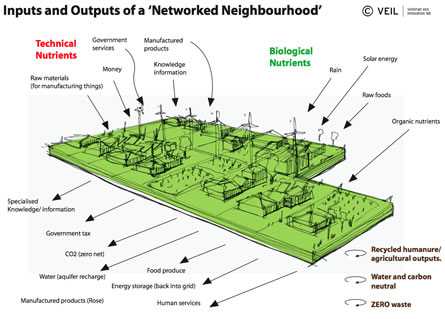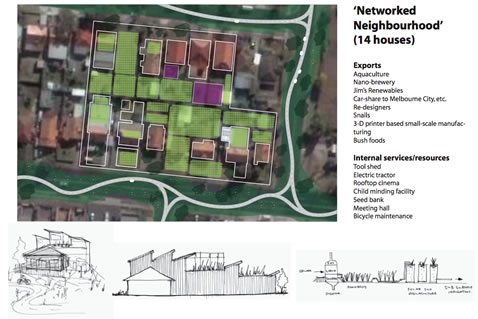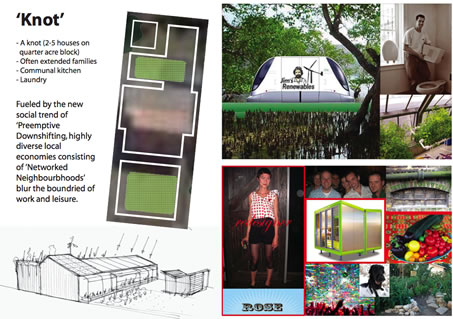Pre-emptive lifestyle shifting
A neighbourhood which is one of the early ‘activity-centre’ developments of the Melbourne 2030 plan.
In the more locally diversified Melbourne many places take on distinct cultural and economic characteristics. These result from the interplay of past policies, infrastructure and businesses investments (both public and private) and the progressive ‘local immigration’ of people attracted to particular amenities, lifestyles and communities.
The Pre-Emptive Downshifters glimpse has a dominant and widely recognised set of conditions particularly suited to a sub-culture of people that have become known as pre-emptive lifestyle-shifters. This group now make up a substantial proportion of the local residents. The name of the sub-culture arose from a humorous reference to a trend in the early years of the century. At that time it was found that about 25% of Australian workers, many in high-profile, high-pressure jobs, voluntarily opted for less demanding and financially less rewarding employment for life-style reasons (to spend time with family or for cultural or practical pursuits, and so on). This phenomenon became widely known as downshifting [See: Hamilton, C]. Pre-emptive lifestyle-shifters are so-called because they have ‘by-passed’ the initial engagement in the high-pressure economy, opting instead to go straight to the lifestyle sought in the downshifting culture (less consumption, less work).
Surveys show that in this locality a high proportion of the local population engage in the ‘mainstream’ economy as a less than full-time commitment (on average 3.5 days /week) . They spend the rest of their work and leisure time in pursuits which, though they may add to their income, are essentially viewed as leisure-work – activities that are more self-directed, which could generally be classified as community-related small businesses. The principle other characteristic of these ‘businesses’ is that most are not-for-profit or never intended to be highly profitable.
A the turn of the century gardening was an important and conflicting focus as a community activity – as a valuable leisure past-time in an aging community and as an activity threatened by years of drought. The growing interest in various movements such as perma-culture, slow food and community-supported agriculture had created a strong nexus between gardening and food-growing. So it is hardly surprising that ‘productive gardening’ for food forms an important part of this locality’s work-leisure activity. However food production extends well beyond the growing of plants.
As on-line earth maps show, land in this site is heavily and diversely cultivated; back and front yards of many older suburban houses, parks, strips along the bike routes, roof-tops of apartment buildings and even lanes of a turn of the century ‘freeway’ are now under production with high-quality, low-volume, seasonable foods (nuts, fruit, vegetables, herbs, flowers).

Food production extends to processing of olive oil, honey, beer and preserves, and so on, now marketed across Melbourne (and beyond) under the much sought-after community brand. Old warehouses and factories are used for farming of fish and yabbies and mushrooms.. Many other activities are food-related (bakeries, restaurants, markets etc).

The area has attracted some mainstream businesses for food-related products and services. These are supported by the research centres of the adjacent university. The best known of these are the Food Information Technology Laboratories and the Active Food-Packaging Research Centre. Some of Melbourne’s best known nutritionists and dietary researchers, chefs and food writers have moved to live in the neighbourhood.
It was recently estimated that the area could provide for about half of the dietary requirements of its inhabitants (though in practice it is much less than this since the output of the area is sold across Melbourne).
The same pattern of small-scale work-leisure activity, linked to research-based mainstream businesses, has developed around the production and storage of renewable energy and around water services and water products. The area supports a small-scale bio-mass combined heat and power (CHP) system selling electricity to the grid and using the heat for a variety of purposes, including to purify waste water. (This system uses gas as a back-up when supply of bio-mass is inadequate.)
Other work-leisure activities involve transport systems and many other ‘normal’ life services, many of which are organised as shared community resources (maintenance workshops, laundry; tools; child care, health, education and entertainment).

The area also has the oldest, and one of the largest, of Melbourne’s Flexible Fabrication Plants. It is widely known that the plants old robots are still capable of complex highly-flexible, economically efficient, manufacturing because of innovative software development made possible by local IT systems and software people and the demands of local industrial ‘re-designers’ (who form a particular sub-set of the pre-emptive down-shifters).
Two Lives
ROSE and KEITH returned to live with Keith’s parents to create what has become known as a Knot on what was once a traditional quarter acre block. They now reside in a small pre-fab home at the rear of the land. The rest of the old garden is under cultivation. Part of Keith’s parents house has become a communal kitchen and laundry, a glasshouse and work-shed. Rose is a ReDesigner; Keith has taken over his fathers business – ‘Jims Renewables’ and is a ‘wetness service engineer’. He is in the process of setting up a ‘Jims Water’ service.

The ‘Pre-emptive Downshifter’ vision was developed as part of the VEIL 2007 Workshops by Stephen Mushin, Dianne Moy & Chris Ryan.